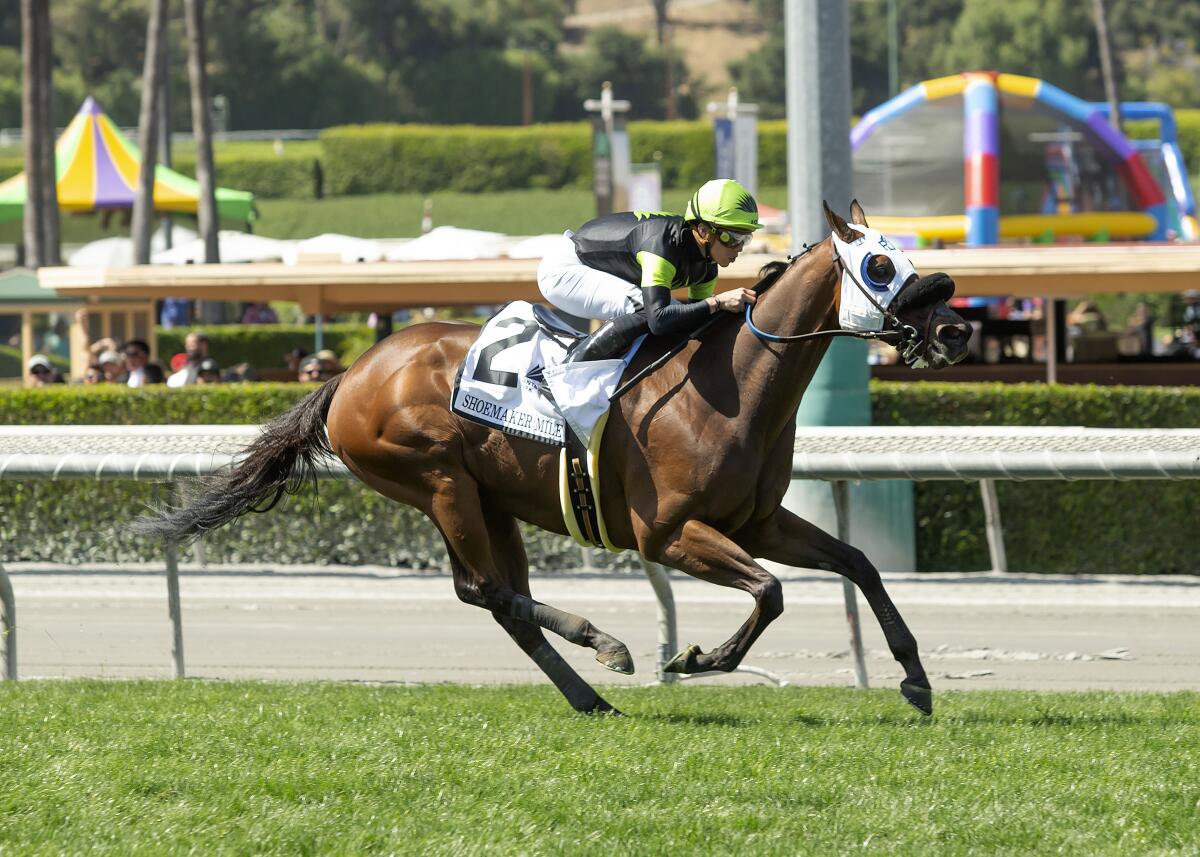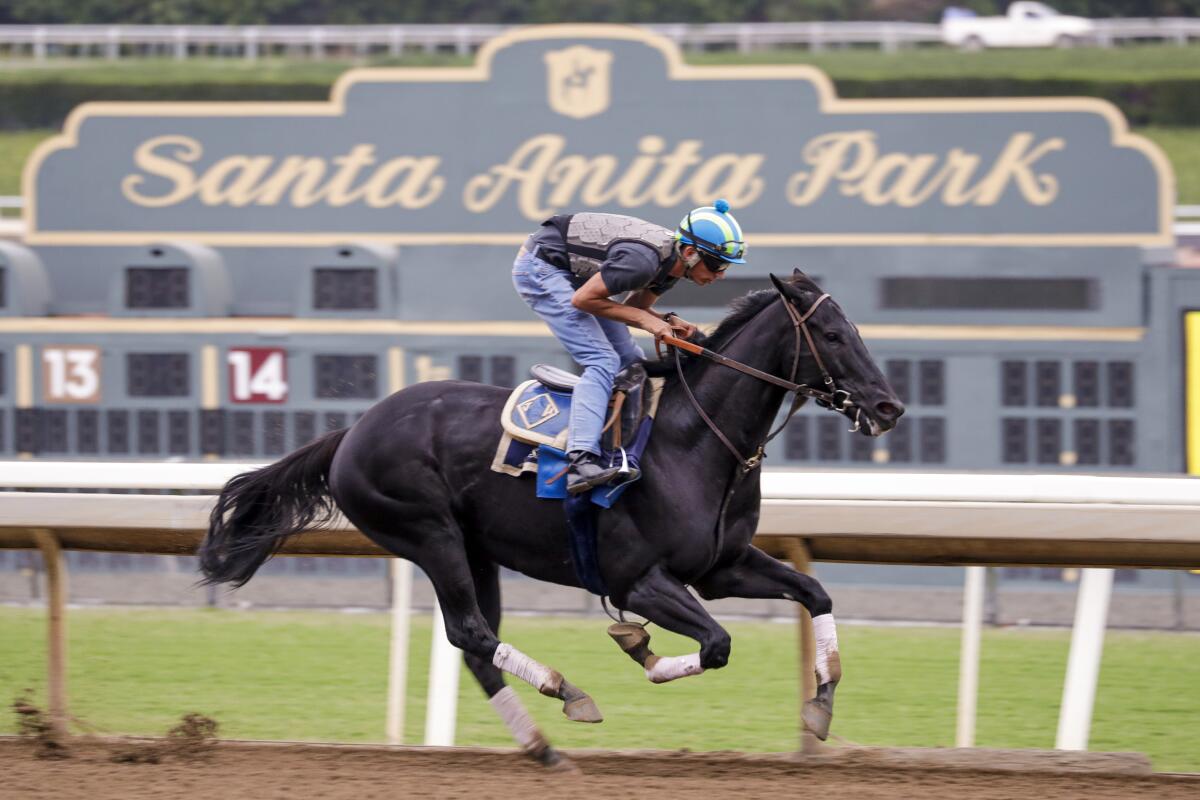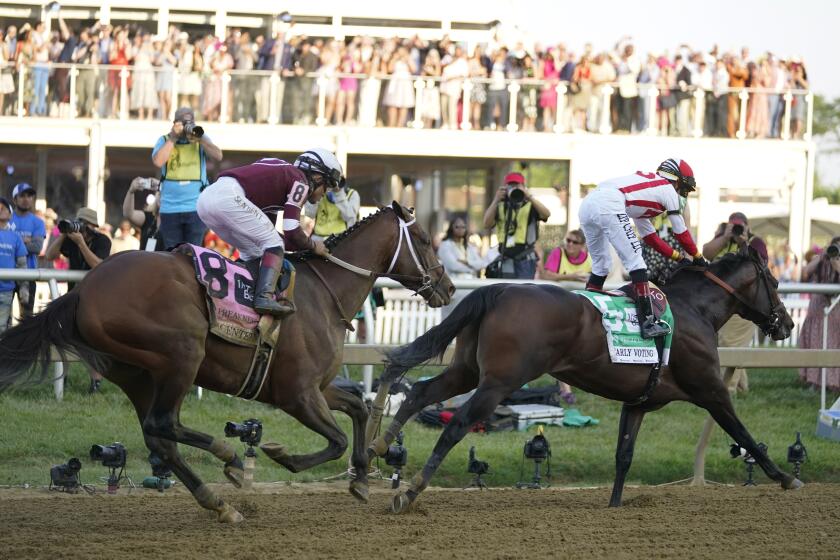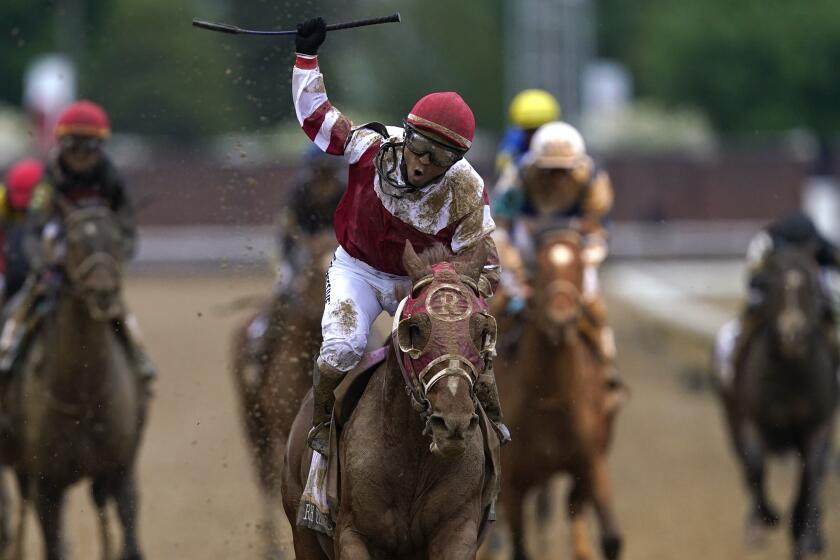Santa Anita ahead of horse racing safety curve in advance of national regulations

- Share via
The infield at Santa Anita had once again been transformed into a carnival atmosphere during the three-day Memorial Day weekend. Besides the normal rides and games employed to occupy the attention of the non-betting members of the family, there were Corgi races. And who doesn’t like to see something that resembles the everyday dog break from a makeshift gate with little idea of what they are supposed to do for a couple dozen yards?
But the real transformation at the legendary Arcadia track has been its attention to, and with great success, in improving equine safety. It needed to erase the memory of 2019 when Santa Anita was a national pariah in the wake of an incredible spike in the number of horse deaths.
Monday was the last big day for the track in its marathon six-month season with three Grade 1 races, including an automatic qualifier for the turf Mile in the Breeders’ Cup on Nov. 5 at Keeneland in Kentucky. Santa Anita is expected to host the Breeders’ Cup for the 11th time next year. No announcement has been made, but the Breeders’ Cup generally follows a California-Kentucky rotation.
Early Voting, coming off six weeks’ rest, beats heavily favored Epicenter to win the 147th running of the Preakness Stakes at Pimlico Race Course.
Racing will continue at Santa Anita with nine more days of racing, finishing up on June 19. There are no more Grade 1 stakes this meeting. Racing then moves to Los Alamitos for a couple weeks before the summer meeting at Del Mar.
So far, in six months, Santa Anita has had eight horse fatalities. Two have been racing, five in training and one by sudden death, which is often associated with a cardiac event. Besides enhanced safety measures currently in play, there have also been fewer weekly races and a slightly smaller horse population.
By comparison, in 2019 Santa Anita reached that number by Jan. 21, finishing with 30 by the end of the meeting. The track shut down for two weeks at the height of the crisis.
If there are no more fatalities, that’s a 73% reduction.
Craig Fravel, chief executive of 1/ST Racing, formerly known as The Stronach Group, was one of the executives brought in to right a ship that had the potential to bring down the entire industry.
In an exclusive interview with the Los Angeles Times at the Preakness in Baltimore this month, Fravel recognized the vast improvement, but knows things aren’t done until the number gets even lower.
“I think it’s important to give credit as credit is due,” Fravel said. “I think the safety improvements are very much a team effort. The California Horse Racing Board, the owners and trainers organizations and the individual trainers, veterinarians on the backstretch, they’ve all contributed to changing outcomes and changing cultures.
“That’s what really had to happen. And I don’t limit it to Santa Anita. Del Mar has been a part of this by doing the same things that we’ve done supporting the same reforms, paying the same amount of attention. And Golden Gate as well.”

Many of the reforms made in California will likely go national in July when the Horseracing Integrity and Safety Authority standardizes rules across the country, if it survives court challenges. Some rules, such as use of the whip by a jockey will be more lax than currently in California but most will be tougher in most national jurisdictions.
“The HISA reforms that are coming down the road this year will put everyone on an even playing field,” Fravel said. “The things that are safety oriented that do frustrate people will be frustrating nationally and not just Southern California.”
Fravel brought up an Arkansas track as a place that has less safety scrutiny.
“Oaklawn should not have been a haven for people who want to behave differently,” Fravel said. “And hopefully in the next year that safety valve, or unsafety valve, won’t be available to people and that’s hugely important.”
Safety was certainly foremost on everyone’s mind before the first race at Santa Anita on Monday when Remi Or Not got loose in the paddock, jumped a fence, headed for the barn area and then did a U-turn back toward people. He was corralled and no one, including the colt, was hurt.
Rich Strike overcame the longest odds on the board to beat out race favorite Epicenter for a stunning victory in the 148th running of the Kentucky Derby.
The rest of the card was highlighted by East Coast jockey Irad Ortiz Jr. winning two of the Grade 1s.
He won the $500,000 Shoemaker Mile to qualify Count Again ($7.00 to win) for the Breeders’ Cup turf Mile by an easy 2¼ lengths.
“I just followed instructions,” Ortiz said. “[Trainer] Phil [D’Amato] told me to let him do his thing and don’t rush him. … The horse was ready [Monday], was ready to win.”
The victory came one race after Ortiz won the 1¼-mile $400,000 Hollywood Gold Cup by a length aboard There Goes Harvard ($19.60) for trainer Michael McCarthy.
“I just can’t thank Irad enough here,” McCarthy said. “Everybody involved, my grooms, my guys, everyone in Barn 59, big day.”
The final Grade 1 stakes of the day, the $400,000 Gamely Stakes for fillies and mares going 1 1/8 miles on the turf, was won by Ocean Road ($12.20) for jockey Umberto Rispoli and trainer Brendan Walsh.
More to Read
Go beyond the scoreboard
Get the latest on L.A.'s teams in the daily Sports Report newsletter.
You may occasionally receive promotional content from the Los Angeles Times.













